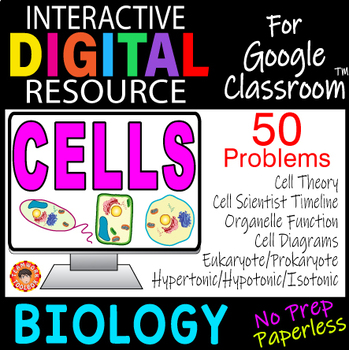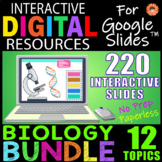CELLS STRUCTURE & FUNCTION ~Digital Resource for Google Slides~ Biology

What educators are saying
Also included in
- SAVE 20% on this Bundle that contains 15 interactive digital resources for Google Slides™ that will help your chemistry students review and master human anatomy concepts throughout the course. Students will drag movable objects, select fill in the blank answers, and type to enter information as thePrice $48.00Original Price $60.00Save $12.00
- ✅12 Resources for Google Slides: This bundle contains 12 interactive digital resources for Google Slides™ that will help your biology students learn and master critical and challenging biology concepts throughout the course. Students will drag movable objects, select fill in the blank answers, andPrice $43.00Original Price $48.00Save $5.00
Description
★Digital Interactive Resource★
Go paperless with this interactive resource for Google Slides™ that will help your Biology and Anatomy students master fundamental cell concepts including: cell theory, cell theory scientists and timeline, prokaryotes vs eukaryotes, organelle functions, osmosis, labeling cell diagrams, and more. Students will drag movable objects and type to enter information as they solve 50 problems on 21 interactive slides. Includes a detailed Teacher Answer Key. This resource will also work well for middle school science courses.
✨✨✨Works great for Distance, In-person, or Hybrid Learning!✨✨✨
Slides can be added, deleted, or rearranged.
Cell Structure and Function Concepts in this Digital Resource
◈Cell Theory
◈Cell Theory Timeline with Hooke, Leeuwenhoek, Schleiden, Schwann, & Virchow
◈Prokaryotes vs Eukaryotes
◈Organelle Functions
◈3 Cell Labeling Diagrams (Animal/Plant/Protist)
◈Osmosis/ Effects of Hypertonic/Hypotonic/Isotonic Solutions on a Cell
★INCLUDED IN THIS RESOURCE★
✅Detailed Directions for Downloading and Assigning the activity
✅21 Interactive Slides with 50 Total Problems
✅Detailed Teacher Answer Key for Each Slide
Technology Required!
***Students must have internet devices capable of using Google Slides™. Google Classroom™ allows you to easily assign students their own copy with just a few mouse clicks (instructions included). This resource is no prep if you already have Google Drive or Google Classroom™ set up. Using Google Drive, you can easily allow students to work in small groups from one device.
★Benefits of using Google Apps★
•No copies to run
•Student work saves automatically
•Students prefer using technology. It's engaging and familiar
•Teachers can easily monitor progress and learning
•You can review student work live and add comments
•Work can be easily assigned or finished as homework
⭐Check out my CELLS: Structure & Function Self-Grading Quiz Assessments for Google⭐
⭐Check out my BIOLOGY Digital Resources for your Google Classroom⭐
⭐Check Out my CHEMISTRY Digital Resources for your Google Classroom⭐
Mole Conversions Digital Resource
Stoichiometry Digital Resource
Acids Bases pH Digital Resource
Measurement & Conversions Digital Resource
Electron Configurations Digital Resource
The Periodic Table Digital Resource
Nuclear Chemistry Digital Resource
Oxidation-Reduction Digital Resource
Specific Heat & Heat Transfer Resource
Gas Laws & Gas Properties Resource
Electron Dot Diagrams Digital Resource
Chemistry Diagrams Review Resource
⭐Check out my ANATOMY Digital Resources for your Google Classroom⭐
Intro to Anatomy Digital Resource
Tissues & The Integumentary System
Peripheral Nervous System (Cranial & Spinal Nerves, Reflexes)






